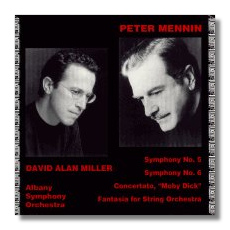
The Internet's Premier Classical Music Source
Related Links
- Mennin Reviews
- Latest Reviews
- More Reviews
-
By Composer
-
Collections
DVD & Blu-ray
Books
Concert Reviews
Articles/Interviews
Software
Audio
Search Amazon
Recommended Links
Site News
 CD Review
CD Review
Peter Mennin

Symphonies
- Fantasia for Strings
- Concertato "Moby Dick"
- Symphony #5
- Symphony #6
Albany Symphony Orchestra/David Alan Miller
Albany 260
Executive Summary: Buy this disc if you like his music, enjoy mainstream American symphonic music of the first half of the 20th Century, are looking to explore this period of music, or even if you already have a recording of these works and like the music.
Peter Mennin was a distinguished composer, educator, and music administrator. He was a pupil of Normand Lockwood, Bernard Rogers and Howard Hanson. The style of Mennin's music is quite romantic in scope and expression, distinguished by his application of vigorous rhythms, a frequent use of imitative techniques like canon, and a very personal, mostly tonal harmonic vocabulary. This is music that grabs your attention and rarely lets go. In the New Grove Dictionary of American Music, Walter Simmons wrote, "While its aggressive energy and syncopated rhythmic drive suggest American roots, its abstract, linear emphasis and lofty tone indicate an affinity with such northern European symphonists as Edmund Rubbra, Vagn Holmboe, and even Allan Pettersson." This can be said of every work of Mennin's I have ever heard, beginning with his Second Symphony of 1944.
The works on this disc were written between the years of 1947 and 1953. Mennin was not a prolific composer yet compositionally this was a very productive period of time for him. He had just completed his Doctorate and was teaching at the Juilliard School. Much of his best music was written during this period, the major exception being his Seventh Symphony of 1963, which in the opinion of many, including myself, is one of the finest essays in symphonic form written in the 20th Century. The late works display an introspection quite different from the extroverted expression to be found in the works before 1965.
In discussing the work, Mennin minimized the influence of Melville's Moby Dick in the writing of the Concertato for Orchestra. It requires no extra musical association to be appreciated. The piece is in two parts, a miniature Concerto for Orchestra. The Fantasia for Strings is also in two parts, a Canzona and Toccata, older forms, which points out the composer's interest in the music of past. The Fifth Symphony is a superb work. The last movement in particular is an orchestral tour de force. The writing is brilliant, engaging, with a clear sense of form that makes the logic of the piece clear. The Sixth Symphony has always seemed less inspiring to me, until this recording. Comparing Miller's interpretation to Whitney's commercial recording and a broadcast recording of a performance by Mitropoulos I find myself more engaged by the thematic material than I have been in the past. While I still don't find the inspiration to be on the level of the Fifth, Seventh or Third Symphonies, it sounds much more convincing than it did before.
Miller's interpretation of the Fifth Symphony in particular is every bit as fine as the Hanson recording and has the added plus of the fine sound quality of the recording and the excellent playing of the Albany Symphony. I certainly won't abandon my broadcast tape of the Fifth conducted by Doráti, but somehow I think I will turn to this new Albany release often.
16 October 1997Copyright © 1997, Karl Miller


















